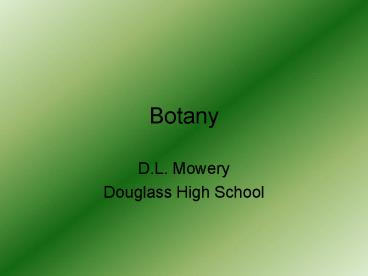Botany - PowerPoint PPT Presentation
1 / 37
Title: Botany
1
Botany
- D.L. Mowery
- Douglass High School
2
Botany
- The Study of Plants
3
Kingdom Plantae
- General Characteristics
- Contain Chlorophyll a
- Multicellular
- Made up of Eukaryotic Cells
- Photosynthetic Autotrophs
- Cell Walls made of Cellulose (polysaccharide)
- Produce sugars as glucose, transport sugars as
sucrose and store sugars as starch
(polysaccharide)
4
Adaptations
- Developed Cuticles
- Waxy, protective outer coverings which prevent
water loss - Developed spores/seeds for reproduction
- Developed vascular tissues for transportation of
water and sugars - Developed tissues to strengthen stems to overcome
gravity
5
(No Transcript)
6
The Classification
- Classified as Bryophytes or Tracheophytes
- Bryophytes are described as plants that lack
xylem and phloem - Xylem is a type of vascular tissue that
transports water upward from the roots to the
leaves - Phloem is a type of vascular tissue that
transports sugars (nutrients) from the leaves
downward - Tracheophytes are plants that have xylem and
phloem
7
Bryophytes
- Moss
- Reproduce through Alternation of Generations..
the Two Generations are the Gametophyte
Generation (n) which produces the gametes, and
the Sporophyte Generation (2n) which produces the
spores - Reproduce by Spores (haploid reproductive cells)
- Lack Xylem and Phloem
- Size limited by lack of Vascular tissue
8
The Life Cycle of Moss
9
The Life Cycle of Moss
Gametophyte Generation (n)
10
The Life Cycle of Moss
Sporophyte Generation (2n)
11
Tracheophytes
- Divided into four groups
- The largest of the four groups are the
- Non-Seed Bearing Plants
- Seed Bearing Plants
12
Non-Seed Bearing Tracheopytes
- Ferns
- They reproduce using spores
- Reproduce through Alternation of Generations
- Have Xylem and Phloem for transportation
13
The Life Cycle of a Fern
14
The Life Cycle of a Fern
¼
(n)
Gametophyte Generation (n)
15
The Life Cycle of a Fern
Sporophyte Generation (2n)
Fronds
Rhizome (contains Xylem and Phloem)
16
The Life Cycle of a Fern
- Underneath the leaflets of the fronds are the
Sori (sorus sng.) - The Sori are made up of the Sporangia
- The Sporangia are the Spore-producing structures
17
Seed Bearing Plants
- Divided into two groups
- Gymnosperms (naked-seed Plants)
- Angiosperms (encased-seed plants)
18
Seed Plant Life Cycle
19
The Gymnosperms are
- Cycads palm-like plants
20
Ginkgoes only one species remains, Ginkgo biloba
21
Conifers pines, firs, redwoods, etc
22
Angiosperms
- Flowering Plants
- Divided into two groups
- Monocotyledons (Monocots)
- Dicotyledons (Dicots)
23
4 Differences
- Monocot
- Leaves Parrallel Veins
- Petals - multiples of 3
- Seeds 1 Cotyledon
- Vascular Monkey face
- Dicot
- Leaves Net Veins
- Petals multiples of 2 or 5
- Seeds 2 Cotyledons
- Vascular - Ring
24
Venation of Leaves
- Dicots
- Venation is nettted
- Monocots
- Venation is Parallel
25
Number of Petals
- Monocots
- Multiples of 3
- Dicots
- Multiples of 4 or 5
26
Seasonal Adaptations
- Evergreens
- Plants that remain green year round
- Pine trees
- Deciduous
- Plants that lose all their leaves once a year
- Apple trees, grapes
27
Short and Long Day Plants
- Short-day Plants Flower when the days are
shorter than 12 hours onions, garlic.
Chrysanthemum a Short-Day Plant
- Long-day Plants - Flower when the days are longer
than 12 hours tomatoes, beans.
28
Growth Cycles
- Annuals
- Complete their entire life cycle in one growing
season - Example mums
- Biennials
- Complete their entire life cycle in two growing
seasons - Example Broccoli
- Perennials
- Continue to grow year after year
- Example Apple trees live for 80 years.
29
Stem Types
- Herbaceous Green, soft.will wilt is water loss
is extreme. Sour grass, celery
- Woody - Brown, rigid. Will remain erect even
after they are dead. trees
30
Review of PhotosynthesisPhotosynthesis is the
process by which plants use the energy of
sunlight to combine carbon dioxide and water to
form glucose and oxygen.
- Light Energy 6CO2 6H20
C6H12O6 6O2
Reactants
Products
31
Factors which Affect Photosynthesis
- Amount of available Sunlight
- Amount of available Water (rainfall)
- Amount of Carbon Dioxide
- Optimal Temperatures
32
Tropisms are the responses plants have to stimuli.
- A Negative (-) response away from the stimuli
- A Positive () response toward to stimuli
- Phototropism a plants response to light
- Gravitropism a plants response to gravity
- Hyrdotropism a plants response to water
- Chemotropism a plants response to chemicals
- Thigmotropism a plants response to touch
33
Phototropism a plants response to light
34
Gravitropism - plants response to gravity
A Corn Root responds positively to gravity
35
Thigmotropism plants response to touch
36
Plant Hormones
- Cytokinins promote cell division, promotes the
germination of dormant seeds - Auxins promote cell elongation in stems and
inhibit elongation in root cells - Gibberillins promotes bolting (sudden growth)
and cessation of dormancy
37
The End

